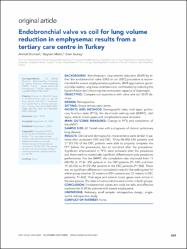| dc.contributor.author | Dumanlı, Ahmet | |
| dc.contributor.author | Metin, Bayram | |
| dc.contributor.author | Günay, Ersin | |
| dc.date.accessioned | 2021-05-05T22:11:50Z | |
| dc.date.available | 2021-05-05T22:11:50Z | |
| dc.date.issued | 2020 | |
| dc.identifier.issn | 0256-4947 | |
| dc.identifier.uri | https://doi.org/10.5144/0256-4947.2020.469 | |
| dc.identifier.uri | https://hdl.handle.net/20.500.12933/168 | |
| dc.description | PubMed: 33307740 | en_US |
| dc.description | 2-s2.0-85097631783 | en_US |
| dc.description.abstract | Background: Bronchoscopic lung volume reduction (BLVR) by either the endobronchial valve (EBV) or coil (EBC) procedure is recommended for severe emphysematous patients. BLVR applications generally help healthy lung areas ventilate more comfortably by reducing the hyperinflation and improving the contraction capacity of diaphragm. Objectives: Compare our experience with valve and coil BLVR devices. Design: Retrospective. Setting: Single tertiary care centre. Patients and Methods: Demographic data, vital signs, pulmonary function tests (PFTs), the six-minute walking test (6MWT), vital signs, arterial blood gases and complications were recorded. Main Outcome Measures: Change in PFTs and completion of the 6MWT. Sample Size: 60 Turkish men with a diagnosis of chronic pulmonary lung disease. Results: Clinical and demographic characteristics were similar in patients who underwent EBV and EBC. Thirty (96.8%) EBV patients and 27 (93.1%) of the EBC patients were able to properly complete the PFT before the procedures, but all complied after the procedures. Significant improvement in PFTs were achieved after the procedure and there were no statistically significant differences in post-procedure performance. For the 6MWT, the completion rate improved from 15 (48.4%) to 19 (61.3%) patients in the EBV patients (P=.125) and from 19 (65.5%) to 21 (72.4%) patients in the EBC patients (P=.500). There was no significant difference in completion rates for the walking test for either group (median 32 meters in EBV patients and 37 meters in EBC patients; P=.652). Vital signs and arterial blood gases were similar in the two groups. The rates of complications were similar in both groups. Conclusion: Endobronchial valves and coils are safe and effective methods for BLVR for patients with severe emphysema. Limitations: Relatively small sample, retrospective design, singlecentre retrospective study. Copyright © 2020, Annals of Saudi Medicine, Saudi Arabia. | en_US |
| dc.language.iso | eng | en_US |
| dc.publisher | King Faisal Specialist Hospital and Research Centre | en_US |
| dc.rights | info:eu-repo/semantics/openAccess | en_US |
| dc.title | Endobronchial valve vs coil for lung volume reduction in emphysema: Results from a tertiary care centre in Turkey | en_US |
| dc.type | article | en_US |
| dc.department | AFSÜ, Tıp Fakültesi, Cerrahi Tıp Bilimleri Bölümü, Göğüs Cerrahisi Ana Bilim Dalı | |
| dc.contributor.institutionauthor | Dumanlı, Ahmet | |
| dc.contributor.institutionauthor | Günay, Ersin | |
| dc.identifier.doi | 10.5144/0256-4947.2020.469 | |
| dc.identifier.volume | 40 | en_US |
| dc.identifier.issue | 6 | en_US |
| dc.identifier.startpage | 469 | en_US |
| dc.identifier.endpage | 476 | en_US |
| dc.relation.journal | Annals of Saudi Medicine | en_US |
| dc.relation.publicationcategory | Makale - Uluslararası Hakemli Dergi - Kurum Öğretim Elemanı | en_US |
















